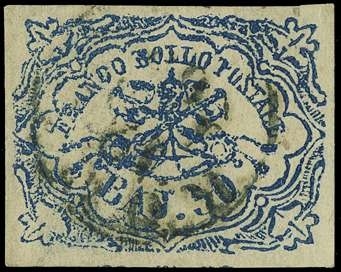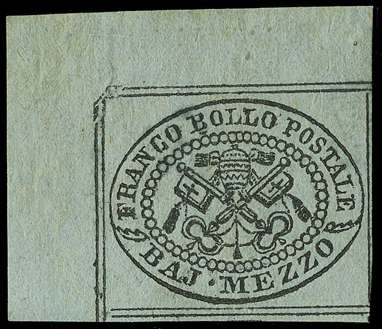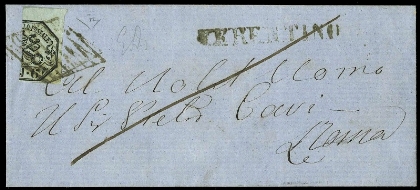The first and only papal series issued in this currency appeared on January 1st 1852. Like all classic issues, it is worth taking a closer look at.
Eleven denominations and a mysterious non-issue
The scudo was the currency in use until 1866: at that time it was worth 5375 lire and was divided into 100 bajocchi. As such, it was used for the first issue of stamps which came out on January 1st 1852, and which remained in circulation until September 20th 1867. The Vatican was the fourth among the Italian States to start printing stamps, and it chose just one image: the crossed keys, topped by a tiara reproduced in various different frames, and in some cases on coloured paper, to make it easier to recognise the particular denomination.
There were eleven of these overall, with face values of 1/2, 1, 2, 3, 4, 5, 6, 7, 8, 50 baj and 1 scudo; for the sake of completeness, the “Giallino” 20 baj should also be mentioned. The latter was printed six years later, in order to offer a simple tariff for France; but for reasons which remain unknown, it was never issued. Two whole sheets of it are known of, one of which is kept at the Vatican’s Philatelic and Numismatic Museum, as well as a single piece. It is a particularly sought-after series, particularly in the two highest face values, which were distributed at head post offices or in Rome only.
But that’s not all. Like all 19th century issues, it offers remarkable uses and printing peculiarities. An excellent selection is presented in the volume published by Zanaria, Stato Pontifico 1852 -1870, by Alberto Barcella, Giorgio Bizzarri, Angelo and Mario Zanaria. For example, the book features stamps used on the first and last day of issue, as well as the only case bearing the date of the day before the official issue, namely December 31st 1851! There is also an ample section covering each face value and featuring various sized blocks, tariffs, destinations and so on.
Our experts state, “The long duration of this issue brought about a large number of print runs, with sometimes remarkable changes in the quality and colour of the paper, generating a vast variety of stamps of the same value, which has helped make them so beloved of stamp-collectors”.
One interesting usage was “sectioned stamps”, in other words stamps cut into different pieces to cover lower tariffs, if no suitable denomination was available. Generally this practice was only tolerated in extreme cases, as it was open to abuse – people could reuse parts of stamps which had remained partially un-franked. The latest net sale price catalogue "Philately and Postal History"; presents some examples, such as the ½ baj and the 6 baj. These are offered at 8,500 and 4,700 euros respectively, against a catalogue valuation of 17,500 and 9,000 euros.
Now from the Vatican to the Romagnas, for a curiosity: the same currency was used in 1859 for the provisional issue of the former Legations (Bologna, Ferrara, Forlì and Ravenna), which had rebelled against Papal rule, and which would soon pass under the rule of Turin.



